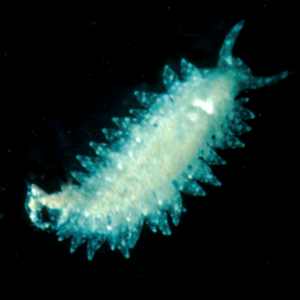Aeolidiopsis ransoni from Great Barrier Reef
July 24, 2002
From: Bill Rudman

Here are some black & white photos and a drawing of the Palythoa-feeding Aeolidiopsis ransoni from Lizard Island, Great Barrier Reef, Australia, off brown Palythoa growing in the shallow sub-littoral; June 4-10 1979. Specimens ranged in length from 8 to 16mm when alive. Further details on the biology of this fascinating Solar-powered nudibranch can be found on the Fact Sheet. Unfortunately I have no good colour photos of this species, although the black & white photos show the difference between the brown speckled form with zooxanthellae, and the white form, which lacks them. I have prepared a separate page with information on its biology and natural history.
Aeolidiopsis ranson was originally described by Pruvot-Fol (1956) from preserved specimens collected on Palythoa at Koukura Is, Tuamota Archipelago, in the eastern central Pacific. A number of inconsistencies between her description and my material are the result of Pruvot-Fol having only preserved material to study. She describes a peculiar animal in which the sole of the foot is rounded and replaces the sides of the body. This is not 'naturelle' as she surmises, but a result of preservation. Some of my preserved specimens, insufficiently narcotized, are similarly deformed. She describes the animals as having a reddish coloration which is also an artefact of preservation, many of my specimens becoming pinkish red in formalin. The absence of cnidosacs in Pruvot-Fol's specimens was also a result of preservation, as specimens can discharge all their nematocysts on preservation, thus rendering the cnidosac difficult to see. Pruvot-Fol erected the genus Aeolidiopsis for this species, citing the general body form, the single row of cerata, the dorsal position of the anus, and absence of cnidosacs, as features distinguishing it from other genera of the Aeolidiidae. Of these characters, the body form as described by her is an artefact of preservation. The single row of cerata along each side, found in smaller specimens, and the large number of almost horizontal rows of few cerata in larger specimens is unusual and is probably derived from the ceratal arrangement in Spurilla, described later in this paper. The fourth character, absence of cnidosacs, is, like the body shape, an error.
The reduced number of flattened cerata, arranged in almost lateral rows, is obviously an adaptation for symbiosis with zooxanthellae. Another distinctive feature is the single rounded anterior edge to the foot. The dorsal position of the anus and kidney opening is unique within the Aeolidiidae. While it is possible that the anal position is a primitive arrangement retained in this species, it is more probable that it is related to the unusual ceratal arrangement. The Aeolidiidae are in need of a generic revision which is outside the scope of this paper. Until this is undertaken I prefer to consider Aeolidiopsis a valid genus, but its relationship to other genera of the family is uncertain. I discuss this further in a separate message.
Best wishes,
Bill Rudman


Related messages
-
Rhinophores of Japanese Aeolidiopsis
From: Nishina Masayoshi, July 25, 2002 -
Egg ribbon of Japanese Aeolidiopsis
From: Nishina Masayoshi, July 25, 2002 -
Aeolidiopsis ransoni from Hachijo Japan (1).
From: Nishina Masayoshi, July 24, 2002 -
Aeolidiopsis ransoni from Hachijo Japan (2).
From: Nishina Masayoshi, July 24, 2002
